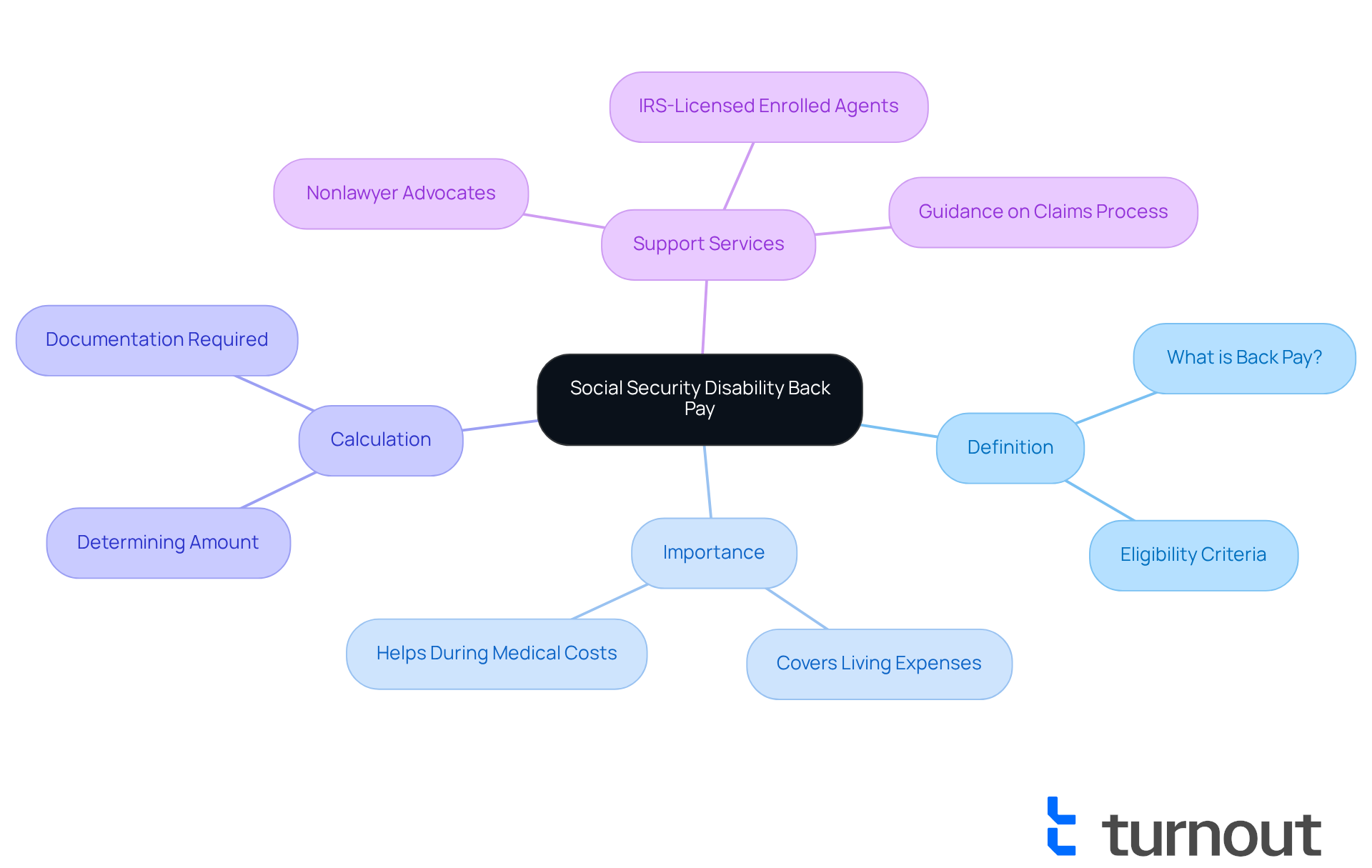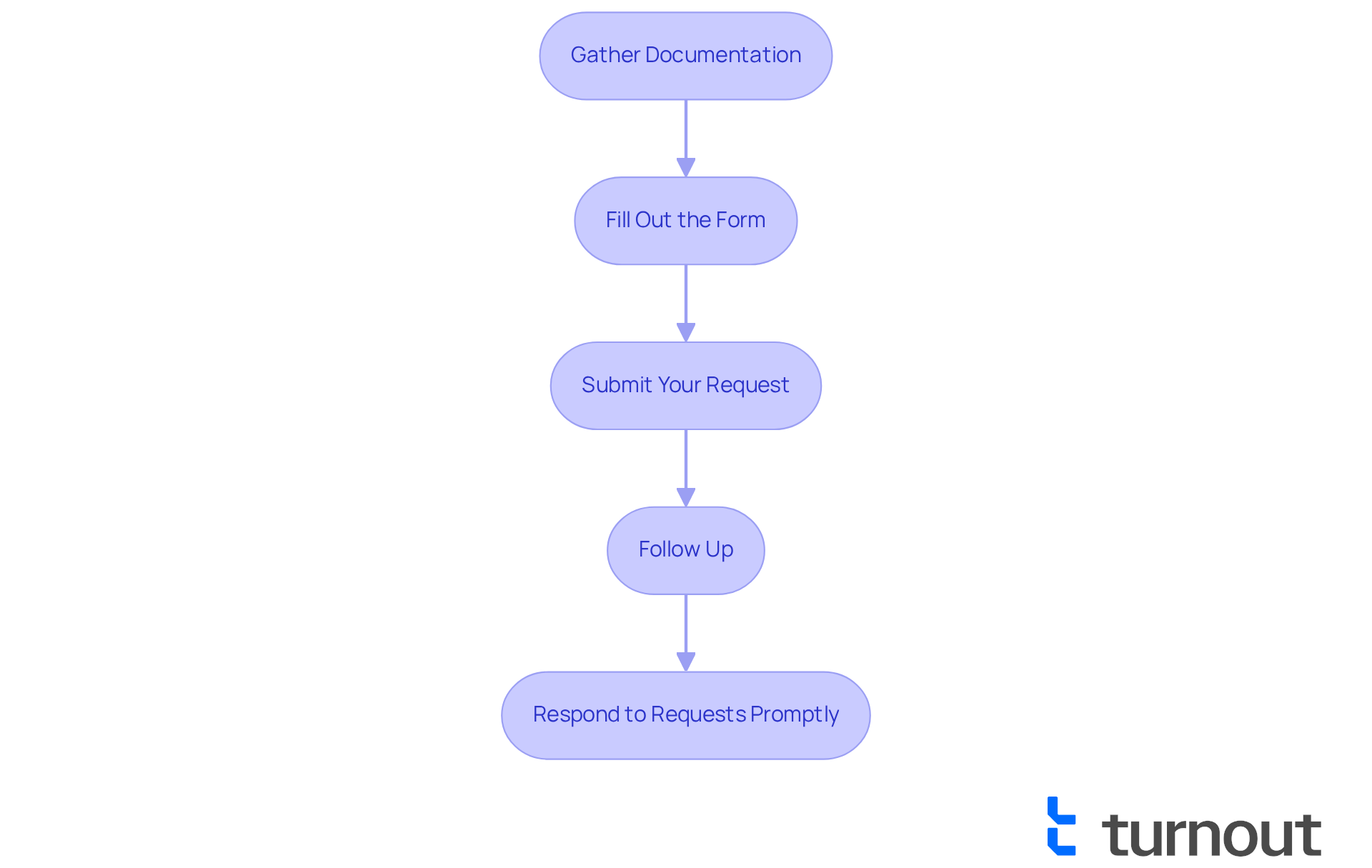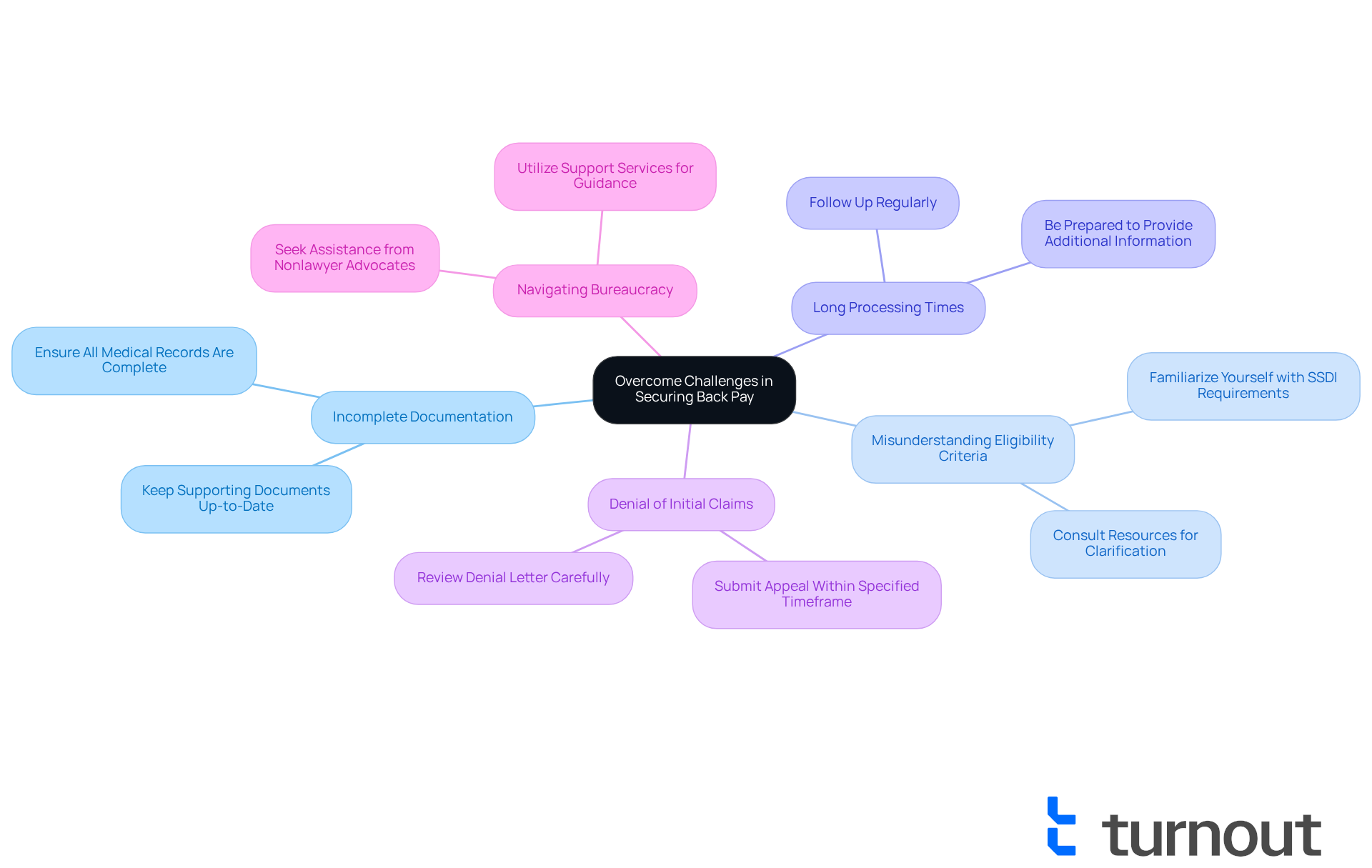Overview
This article aims to support you in understanding how to effectively calculate and claim Social Security Disability back pay. This compensation is crucial as it covers the period between when your disability began and when your SSDI application was approved. We understand that this process can feel overwhelming, and we are here to help you navigate it with confidence.
You will find essential guidance on determining the amount of back pay you may be owed. Key factors include:
- Your disability onset date
- The approval date of your application
- Your monthly benefit amounts
It’s common to feel uncertain about these details, but with thorough documentation, you can clarify your situation and ensure you receive the support you deserve.
As you embark on this journey, remember that you are not alone. Many have successfully navigated this process, and with the right information and support, you can too. We encourage you to take action by gathering your documentation and seeking assistance as needed. Together, we can work towards a brighter future.
Introduction
Understanding Social Security Disability Back Pay is crucial for those facing the complexities of disability benefits. We recognize that this retroactive compensation can provide significant relief during a challenging time, covering the gap between when your disability began and when your application is approved.
However, navigating the process of calculating and claiming these benefits can feel overwhelming. Many may wonder: how can you secure the benefits you deserve while overcoming the obstacles that may arise?
We're here to help you through this journey.
Define Social Security Disability Back Pay
The benefits owed to individuals for the period between their disability onset and the approval of their Social Security Disability Insurance (SSDI) application are referred to as Social Security Disability Back Pay. This payment represents social security disability back pay for the time you were unable to work due to your disability, during which you had not yet received any benefits. We understand that grasping the concept of retroactive pay is crucial; it can represent a significant amount of money that helps cover living expenses and medical costs during a challenging time.
It’s important to recognize that retroactive compensation is determined by the point of disability onset, which must be documented and verified through medical records. At Turnout, we’re here to help you navigate the complexities of SSD claims. We provide tools and services, including trained nonlawyer advocates and IRS-licensed enrolled agents, to ensure you understand your rights and the processes involved in claiming social security disability back pay. You are not alone in this journey; our approach allows you to seek assistance without the need for legal representation.

Calculate Your Back Pay: Key Factors and Timelines
Calculating your Social Security Disability Back Pay can feel overwhelming, but understanding a few key factors can help ease your journey:
-
Disability Onset: This is the moment your disability began, as recognized by the Social Security Administration (SSA). Providing medical documentation to support this timeline is crucial.
-
Application Approval Timestamp: This marks when your SSDI application is officially accepted. The calculation of social security disability back pay is based on the period from the onset of your disability to the approval date.
-
Monthly Benefit Amount: Your monthly SSDI benefit is based on your work history and earnings. This amount will be multiplied by the number of months between your onset and approval dates to determine your total retroactive payment.
-
Waiting Period: There is a five-month waiting period for SSDI benefits, which means you won’t receive retroactive payments for the first five months after your disability onset. Understanding this waiting period is essential, as it directly impacts the amount of social security disability back pay you may receive.
Example Calculation: Let’s say your disability onset is January 1, 2023, and your request is approved on January 1, 2024. Your retroactive payment would cover the months from June 2023 to January 2024, minus the five-month waiting period. If your monthly benefit is $1,200, your total retroactive payment would be $7,200 (6 months x $1,200). This example illustrates how social security disability back pay can cover up to 12 months prior to your application date, highlighting the potential for significant compensation.
It's vital to maintain thorough documentation of your medical conditions, treatment history, work history, and limitations to support your claim. As Michael D. emphasized, understanding the nuances of the SSDI process can help ensure you receive the highest social security disability back pay for which you qualify. Remember, you are not alone in this journey. With the right information and support, you can navigate the complexities of social security disability back pay and secure the benefits you deserve. Turnout is here to assist you, utilizing trained nonlawyer advocates to help you effectively navigate your SSD claims.

Navigate the Application Process for Back Pay
Navigating the application process for social security disability back pay can feel overwhelming, but with the support of Turnout, you are not alone. Here’s how to take each step with confidence:
-
Gather Documentation: Start by collecting all necessary medical records, work history, and any other documentation that supports your claim. This includes evidence of your disability and its impact on your ability to work. We understand that this can be a daunting task, but it’s a crucial first step.
-
Fill Out the Form: Take your time to accurately complete the SSDI form. You have the option to apply online, by phone, or in person at your local Social Security office. Make sure to include all relevant information regarding your disability and work history. Remember, every detail matters.
-
Submit Your Request: Once you’ve completed the form, submit your request along with all supporting documents. Keeping copies of everything you send is essential for your records. It’s common to feel anxious at this stage, but you’re making progress.
-
Follow Up: After submission, regularly check the status of your request. You can do this online or by contacting the SSA. Be prepared to provide additional information if requested. We understand how important this is to you, and staying informed can help ease your mind.
-
Respond to Requests Promptly: If the SSA asks for additional documentation or clarification, reply as swiftly as possible to prevent delays in processing your submission. We know that waiting can be stressful, and timely responses can make a difference.
Turnout is here to assist you throughout this process. Our trained nonlawyer advocates are dedicated to helping you navigate the complexities of SSD claims, ensuring you feel supported every step of the way.

Overcome Challenges in Securing Back Pay
Securing social security disability back pay can indeed present challenges. We understand that navigating this process can feel overwhelming, but there are ways to overcome common obstacles.
-
Incomplete Documentation: One of the most frequent reasons for delays or denials is insufficient documentation. Ensure that all medical records and supporting documents are complete and up-to-date. This step is crucial in making your case stronger.
-
Misunderstanding Eligibility Criteria: Many applicants are unaware of the specific eligibility criteria for SSDI. It's common to feel confused about these requirements. Take the time to familiarize yourself with them to prevent submitting a request that could be rejected.
-
Long Processing Times: The SSDI submission process can be lengthy. We encourage you to stay proactive by following up regularly and being prepared to provide additional information if needed. Remember, persistence is key.
-
Denial of Initial Claims: If your application is denied, do not be discouraged. You have the right to appeal the decision. Review the denial letter carefully, address the reasons for denial, and submit your appeal within the specified timeframe. You are not alone in this journey; many have faced similar setbacks and succeeded.
-
Navigating Bureaucracy: The SSDI system can be complex and frustrating. Consider seeking assistance from Turnout, where nonlawyer advocates can help you navigate the process and improve your chances of securing social security disability back pay. Turnout is not a law firm and does not provide legal advice, but is dedicated to providing support without the need for legal representation. We're here to help you ensure you have the guidance necessary to successfully manage your SSD claims.

Conclusion
Understanding Social Security Disability back pay is crucial for those navigating the complexities of SSDI claims. We know that this retroactive payment can provide essential financial support, covering the gap between the onset of disability and the approval of benefits. By grasping the intricacies of this process, you can ensure that you receive the compensation you rightfully deserve.
Key factors such as the disability onset date, application approval timestamp, monthly benefit amount, and the waiting period significantly impact the calculation of back pay. It's important to approach this process proactively. Thorough documentation can help you overcome challenges like incomplete records, misunderstandings about eligibility, and long processing times. Remember, resources like Turnout are here to provide invaluable support, guiding you through each step and helping you address potential obstacles.
Ultimately, securing Social Security Disability back pay not only alleviates financial strain but also empowers you to focus on your health and recovery. We understand that this journey can be overwhelming, but by staying informed and persistent, you can navigate the SSDI system effectively, ensuring you receive the benefits you are entitled to. Taking action today can pave the way for a more secure and stable future. You are not alone in this journey; we're here to help.
Frequently Asked Questions
What is Social Security Disability Back Pay?
Social Security Disability Back Pay refers to the benefits owed to individuals for the period between their disability onset and the approval of their Social Security Disability Insurance (SSDI) application. It represents the payments for the time an individual was unable to work due to their disability before receiving any benefits.
Why is understanding retroactive pay important?
Understanding retroactive pay is crucial because it can represent a significant amount of money that helps cover living expenses and medical costs during a challenging time when an individual is unable to work.
How is retroactive compensation determined?
Retroactive compensation is determined by the point of disability onset, which must be documented and verified through medical records.
What services does Turnout provide for SSD claims?
Turnout provides tools and services, including trained nonlawyer advocates and IRS-licensed enrolled agents, to help individuals understand their rights and the processes involved in claiming social security disability back pay.
Do I need legal representation to seek assistance with my SSD claim?
No, you do not need legal representation to seek assistance with your SSD claim. Turnout offers support that allows you to navigate the process without the need for a lawyer.




